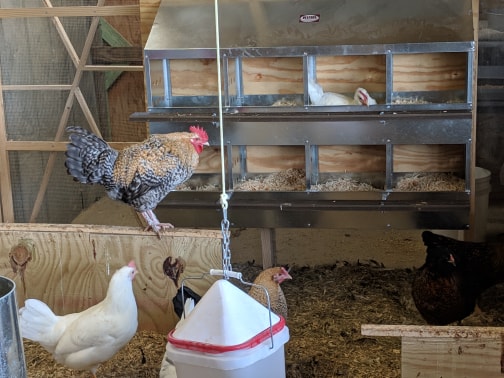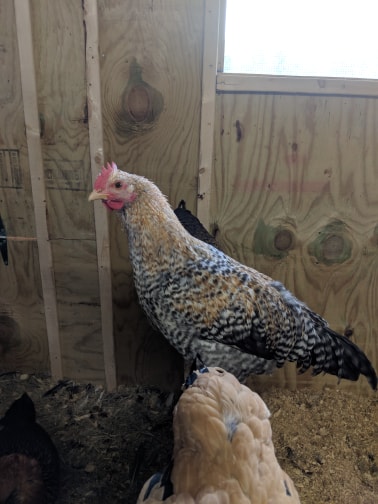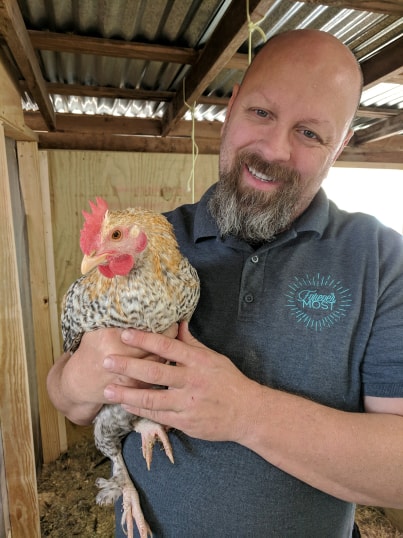
As we have been setting up our Farm/Homestead, we have learned a LOT about the animals and plants we are raising. Some things we have learned the hard way, by making mistakes in what we have purchased. As an example, our first round of day-old chicks were purchased through a hatchery. I think that this is what most people do when they are starting out or do not know any better or don’t really care what they own from a blood-line point of view. When we first ordered chickens, we fell into all three of these categories.
Some of what we have learned has been through reading. We have spent countless hours learning everything we can to raise our animals and grow our plants in a way that both fits our personal philosophy and economics. We want to improve our health by reducing the amount of herbicides, pesticides and antibiotics we may be taking into our bodies when we purchase store bought food and it is important that what we raise is economical to produce and reproduce on a sustainable level. We have joined online groups that buy and sell fertilized eggs and local day-old chicks. This has allowed us to actually see the stock our eggs have come from and has reduced the price we have paid for chickens. Who thought that you could purchase better quality products at a lower price just by finding a local farmer to buy from?
Most of what we are learning will come from time. The longer we keep at this, the better we will become and the better our food will be.
When we first ordered our hens, our primary focus was eggs. We knew we wanted multi-colored eggs that ranged from blue to green and white to dark brown. Therefore, we bought a plethora of different breeds to make an Easter-like basket of colorful eggs. We even bought “Easter Egger” chickens. We didn’t know that Easter Egger chickens are a marketing term that indicates chickens that are cross-bred to get a desirable color egg and not purebred. This creates all sorts of possibilities for egg color based on genetics. We didn’t know that that there were variations of each of these colors and the different variations of color could also indicate the nutritional quality of the egg. By having stronger breeding and better nutrition for your chickens, you could create darker brown eggs or bluer blue eggs or deeper green eggs with deeper colored yolks. These eggs actually taste better and have higher nutritional value.

We have learned that the profit you can make from eggs changes based on what you are selling and how you are selling them. If you were to sell a dozen eggs, for human consumption, in a rainbow of colors, you can make between $3.50 and $5.00 a dozen at local farmer’s markets and through friends and family. If you separate out your breeds and focus on just a few of the most desired eggs and chickens, you will pay the same amount of money for food and shelter and can sell eggs that are fertilized for other farms and homesteads to hatch their own chickens. Selling eggs in this manner can bring anywhere from $10-$50 per dozen (or more). That is a healthy increase in profit, for the same amount of product. A step beyond this is to incubate the eggs and sell day-old chicks. This is not a year round source of income, but designer baby chicks sell for $5-$30 each (or more). That dozen eggs (if all hatched) is now worth $60-$350. Once you learn who to sell to and how to sell your eggs/chickens, the income potential changes substantially.
We will continue to raise our original 23 hens for eggs to eat. We have also decided to start raising chickens that are desired for their edible eggs, fertilized eggs and flavorful meat. The two breeds we have started are Marans and Ayam Cemanis. More on the Cemanis in a future post.
Marans are dual purpose birds (good for both eggs and meat) that lay between 150-200 large dark russet brown eggs per year. The quality of the egg and breed is actually determined by a Marans egg color chart that rates the egg from 1-9 (9 being most desirable).

The breed was developed in the in southwestern France in a town named Marans beginning in the 13th century. The United Kingdom began importing these chickens in the 1930s and they found their way into the United States shortly after World War 2.
The show standard for the chickens differs slightly based on country. The main difference is the color variety recognized and if they have feathered legs or not. The original chickens had feathered legs and this is the standard in the US and France, but the British prefer a clean legged variety. All Marans should have bright orange colored eyes. Shanks are usually slate or pink and the soles of their feet are always white because Marans have white skin instead of yellow. In the US, the American Poultry Association lists the bird in the Continental Breed (breeds from Belgium, France, Germany and Netherlands) and ONLY recognizes three colors: Black Copper, Wheaten and White. There are many other variations that are not officially recognized, with the most popular being Golden Cuckoo, Black, Blue, Columbian, Birchen and many more.

The most common mistakes I see on forum groups is name pronunciation. The S is silent and the emphasis is on the second syllable. People also confuse Black and Black Copper. I have seen posts where people are selling Black Marans and they are calling them French Black Copper. The Black Copper is black with copper colored feathers around their neck. This generally lays the darkest of eggs. Many people refer to their chickens as “French”, which is unnecessary unless specifically describing the chicken to have feathered legs and fitting the French standard.
At our Farm, we are currently raising Golden Cuckoo, Black, Blue and Splash colored varieties. Once these variations are firmly established, we may add different colors, but for now we are working on the genetics of our flock to produce a superior egg.
If you don’t already, please follow us on Facebook at ForevermostFarms.

